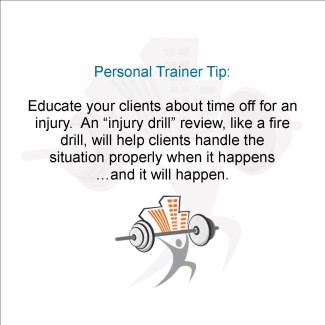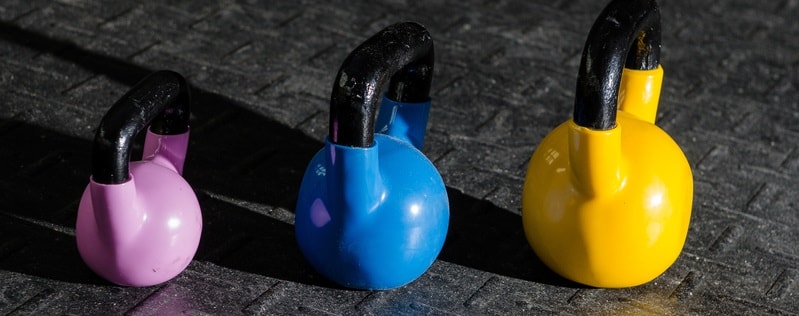August 6, 2014
 In the children’s program Doc McStuffins, there is a song that starts “Everyone gets hurt sometimes.” While this may have been about a toy breaking, the line holds true for people, too. From athletes to sedentary people, injuries happen. The bigger question is how do you handle them? This is not about handling it from a first aid perspective, but really handling the injury time off from training, as many people experience disappointment, or even mild depression from not training. As a personal trainer, it is wise to review these scenarios with clients, as it may come in handy to have a plan to manage a client’s expectations. An injury drill, like a fire drill you practiced in grade school or in the office can stave off any panic or negative behavior. Mental state No matter what the injury, big or small, a person’s mental state can be the biggest factor in how a pause in training is affected. It is important to keep an upbeat attitude about the recovery. The injury is preventing them from exercising, thus a glass half full look at recovery is helpful. Every day of recovery gets one closer to training sessions again. The hope is that you come back smarter and stronger in the long run. Don’t get down. Injuries are a part of the game. Injury work around In most cases, injuries do not mean a total shutdown from the gym. A personal trainer should be capable of creating a work around program to keep the activity flow going. It may simply mean a time to refocus training on another area, body part, or trying something new. Perhaps the long term plan just needs to be scrambled and reconfigured. A forearm injury may mean concentrating more on strengthening your legs. A leg injury could mean more focus on upper body workouts. New York City is a very walk-friendly environment. A New York City personal trainer can help you devise a walking plan in place of your training sessions for a little while. Nutrition Nothing can send your fitness goals into a downward spiral faster than the combination of poor eating and inactivity. As mentioned before, being injured and unable to exercise can lead some people to be depressed or stressed. When you reach either of those mental states, many people turn to food for comfort. Or more than likely comfort foods, as ice cream, cookies, and the likes are aptly named. Knowing how to notice the signs of these bad decisions and how to stop them before they happen can aid in your recovery and may lessen any adverse affects of the layoff. Additionally, a person may want to seek out foods that can aid in the recovery. If that is not applicable to the situation, then at best seek to find a nutritional plan that may be lower in calories than your daily food intake is when you are exercising at full capacity. Weight management could be your best ally. Alternative activities There are other issues could prompt a client to need new modalities. A personal trainer who is certified in yoga or Pilates may have the upper understand hand as you can keep the training in-house instead of bringing in an additional fitness professional. If your injury is impact related and you are a runner, you may need to switch to swimming. Swimming is still a great form of cardiovascular activity and also incorporates more upper body strength. Manhattan may be short on pools, but they do exist in many of the newer apartment buildings and a few gyms. A personal trainer in Manhattan should know where some of them can be found. Doctor consult Consulting with your primary care physician does not necessarily mean going in for a visit. Consider making a phone call to inform your doctor of the injury. From a preliminary conversation, they may be able to estimate a recovery time and provide some best care practices. However, depending on the extent of the injury, you may need to go in for a visit so you can get a better sense of what to expect, manage expectations and any limitations or restrictions. A personal trainer may help you draw the line between putting your leg up on the couch for a few days and going to see your doctor. The bottom line here is that if you have a plan or an idea of what to do when an injury occurs. You are more likely to remain calm in the face of disappointment. Recognize that injuries are part of an active healthy lifestyle. Proper recovery is another part of it. You’ll be back in the gym as soon as possible.
In the children’s program Doc McStuffins, there is a song that starts “Everyone gets hurt sometimes.” While this may have been about a toy breaking, the line holds true for people, too. From athletes to sedentary people, injuries happen. The bigger question is how do you handle them? This is not about handling it from a first aid perspective, but really handling the injury time off from training, as many people experience disappointment, or even mild depression from not training. As a personal trainer, it is wise to review these scenarios with clients, as it may come in handy to have a plan to manage a client’s expectations. An injury drill, like a fire drill you practiced in grade school or in the office can stave off any panic or negative behavior. Mental state No matter what the injury, big or small, a person’s mental state can be the biggest factor in how a pause in training is affected. It is important to keep an upbeat attitude about the recovery. The injury is preventing them from exercising, thus a glass half full look at recovery is helpful. Every day of recovery gets one closer to training sessions again. The hope is that you come back smarter and stronger in the long run. Don’t get down. Injuries are a part of the game. Injury work around In most cases, injuries do not mean a total shutdown from the gym. A personal trainer should be capable of creating a work around program to keep the activity flow going. It may simply mean a time to refocus training on another area, body part, or trying something new. Perhaps the long term plan just needs to be scrambled and reconfigured. A forearm injury may mean concentrating more on strengthening your legs. A leg injury could mean more focus on upper body workouts. New York City is a very walk-friendly environment. A New York City personal trainer can help you devise a walking plan in place of your training sessions for a little while. Nutrition Nothing can send your fitness goals into a downward spiral faster than the combination of poor eating and inactivity. As mentioned before, being injured and unable to exercise can lead some people to be depressed or stressed. When you reach either of those mental states, many people turn to food for comfort. Or more than likely comfort foods, as ice cream, cookies, and the likes are aptly named. Knowing how to notice the signs of these bad decisions and how to stop them before they happen can aid in your recovery and may lessen any adverse affects of the layoff. Additionally, a person may want to seek out foods that can aid in the recovery. If that is not applicable to the situation, then at best seek to find a nutritional plan that may be lower in calories than your daily food intake is when you are exercising at full capacity. Weight management could be your best ally. Alternative activities There are other issues could prompt a client to need new modalities. A personal trainer who is certified in yoga or Pilates may have the upper understand hand as you can keep the training in-house instead of bringing in an additional fitness professional. If your injury is impact related and you are a runner, you may need to switch to swimming. Swimming is still a great form of cardiovascular activity and also incorporates more upper body strength. Manhattan may be short on pools, but they do exist in many of the newer apartment buildings and a few gyms. A personal trainer in Manhattan should know where some of them can be found. Doctor consult Consulting with your primary care physician does not necessarily mean going in for a visit. Consider making a phone call to inform your doctor of the injury. From a preliminary conversation, they may be able to estimate a recovery time and provide some best care practices. However, depending on the extent of the injury, you may need to go in for a visit so you can get a better sense of what to expect, manage expectations and any limitations or restrictions. A personal trainer may help you draw the line between putting your leg up on the couch for a few days and going to see your doctor. The bottom line here is that if you have a plan or an idea of what to do when an injury occurs. You are more likely to remain calm in the face of disappointment. Recognize that injuries are part of an active healthy lifestyle. Proper recovery is another part of it. You’ll be back in the gym as soon as possible.












